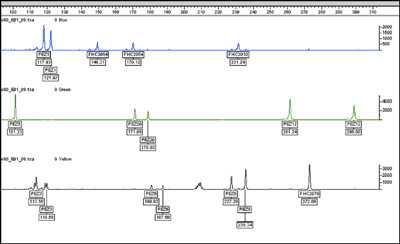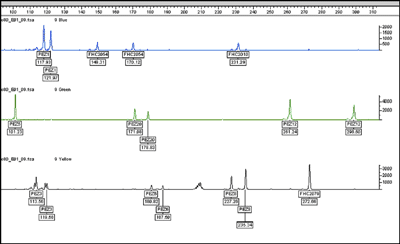Archival Notice
This is an archive page that is no longer being updated. It may contain outdated information and links may no longer function as originally intended.
Home | Glossary | Resources | Help | Contact Us | Course Map
Many crimes occur in houses in which domestic pets, particularly cats and dogs, reside. For example, a survey conducted by the American Veterinary Medical Association in 2002 determined there are more than 70 million pet cats and 60 million pet dogs in the United States.20 Some studies have indicated that there is a high probability of transfer of shed pet hairs from such residences to visitors and owners alike.21 Apart from the direct transfer of dog and cat hairs from the crime scene and secondary transfer from the pet owner to another individual, there are other case circumstances which involve the domestic dog. In the case of assault on a human by a dog, there will often be a transfer of saliva from the dog to the victim. As these examples show, the ability to individualize particular dogs and cats by DNA analysis could represent an important source of probative evidence.
Domestic Cat (Felis catus)
Extraction of DNA from the roots of cat hairs can be performed using standard methods employed by crime laboratories. A novel PCR (Polymerase Chain Reaction) based method permits quantification of the low amounts of DNA obtained from domestic cat hair samples.22 This method uses amplification of SINE (Short INterspersed Element) elements located in the Felis catus MHC and is reported to be able to detect as little as 10 femtogram (fg) of feline genomic DNA. The regions targeted by the primers in this method exhibit some degree of conservation with other species. However, if single cat hairs are used, the possibility of amplification from another species is believed by the authors to be minimal due to the washing of the root prior to DNA analysis.
Genomic sequence information is now available for the domestic cat and has resulted in the identification of numerous microsatellites.23-25 Based on the successful use of microsatellites in human individualization, attempts have been made to evaluate the use of feline microsatellites for forensic use.26 A multiplex system, MeowPlex, comprising 11 tetranucleotide STR markers and a gender determination marker, has been specifically designed to be compatible with current forensic DNA analysis instrument platforms and protocols.27 Match probabilities using this system have been reported to be in the range of 10-7 to 10-13.27 The figure below illustrates the Meowplex STR (Short Tandem Repeats) genetic profiles obtained from a male and female cat.
Domestic Dog (Canis familiaris)
Hundreds of microsatellite loci have been identified throughout the canine genome and used for genetic mapping and parentage testing.28-35 Population studies on 15 canine-specific polymorphic STR loci have been conducted to help determine their usefulness in forensic casework.26 The Stockmarks for Dogs Canine 1 amplification kit is commercially available from Applied Biosystems and comprises 10 STR loci.36 A second amplification kit, Canine 2, was discontinued since the discriminating ability of Canine 1 was sufficient for most cases.36 An example of an electropherogram from a dog using the Stockmarks for Dogs Canine 1 system is provided in the figure below.
Animal Case Example (STRs) |
|---|
| In the case of State of Washington v. Kenneth Leuluaialii and George Tuilefano, Kenneth Leuluaialii and Geroge Tuilefano were charged with the murders of Jay Johnson, Raquel Rivera, and their dog, Chief.36,37 Blood evidence that was taken from the suspects' pants and jackets was determined to be non-human, and the use of canine STR analysis allowed for identification of the blood evidence as matching that of Chief. The likelihood of the match was determined to be 1.5x107 and 4.82x109 for the blood taken from the pants and the jacket, respectively.36 |
Canine STR analysis normally requires the recovery of nuclear DNA from hair evidence taken from a crime scene. Akin to human DNA testing, the root of the hair needs to be present in order to extract sufficient quantities of nuclear DNA for STR analysis. However, mitochondrial DNA is present in higher copy number than nuclear DNA and can be recovered from the hair shaft. The sequence of the mitochondrial genome for the domestic dog (Canis Familiaris) is known.38 Approaches to mitochondrial DNA profiling of dog hairs have included sequence variation in the 5' end of the mtDNA hypervariable region (HVR) and also sequence and length variation within a variable and heteroplasmic tandem repeat region in the mtDNA control region (CR).39 In dogs, this region contains arrays of 10 base pair sequences that are repeated between 25 and 35 times. In addition to variability in the number of these repeat array sequences, there are two types of the 10 base pair repeats, differing in sequence by one base, known as the "informative position. "Through examination of both length and sequence variations, it was found that individual hairs from the same dog could contain different numbers of the 10-base pair repeats and therefore would not be suitable for use with single hairs. However, when sequence variation was examined between individual hairs from the same dog, they contained identical sequences and therefore this approach may be more suitable for use in forensic casework.40
Casework Example with Canine mtDNA |
|---|
| A dog was suspected of having caused a traffic accident, but left the scene. The driver of the car thought he knew the identity of the dog, and a lawsuit was filed against the owner's of the dog. The suspected dog had received treatment for injuries shortly after the time of the accident, which added to the appearance of the dog's guilt. However, hairs were found on the driver's car, and mitochondrial DNA testing was performed on the recovered hairs and reference hairs and saliva taken from the suspected dog. The results indicated that the recovered hairs did not originate from the suspected dog, and the lawsuit was subsequently dismissed.41 |
Additional Online Courses
- What Every First Responding Officer Should Know About DNA Evidence
- Collecting DNA Evidence at Property Crime Scenes
- DNA – A Prosecutor’s Practice Notebook
- Crime Scene and DNA Basics
- Laboratory Safety Programs
- DNA Amplification
- Population Genetics and Statistics
- Non-STR DNA Markers: SNPs, Y-STRs, LCN and mtDNA
- Firearms Examiner Training
- Forensic DNA Education for Law Enforcement Decisionmakers
- What Every Investigator and Evidence Technician Should Know About DNA Evidence
- Principles of Forensic DNA for Officers of the Court
- Law 101: Legal Guide for the Forensic Expert
- Laboratory Orientation and Testing of Body Fluids and Tissues
- DNA Extraction and Quantitation
- STR Data Analysis and Interpretation
- Communication Skills, Report Writing, and Courtroom Testimony
- Español for Law Enforcement
- Amplified DNA Product Separation for Forensic Analysts



